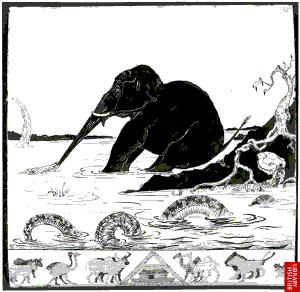 According to the researchers an ancient jawbone showed that nature's largest mouths probably evolved to suck in large prey rather than to engulf plankton-filled water. The prehistoric jaw, was very different from modern baleen whales where the lower jaw does not fuse at the "chin". Instead there is a specialised jaw joint that allows each side of the jaw to rotate. By having two curved lower jaw bones that rotate in this way, baleen whales are able to produce huge gapes to take in massive quantities of water and prey.
According to the researchers an ancient jawbone showed that nature's largest mouths probably evolved to suck in large prey rather than to engulf plankton-filled water. The prehistoric jaw, was very different from modern baleen whales where the lower jaw does not fuse at the "chin". Instead there is a specialised jaw joint that allows each side of the jaw to rotate. By having two curved lower jaw bones that rotate in this way, baleen whales are able to produce huge gapes to take in massive quantities of water and prey.Lead researcher, Erich Fitzgerald said: "This is compelling evidence that these archaic baleen whales could not expand and rotate their lower jaws, which enables living baleen whales to engulf and expel huge volumes of seawater when filter feeding on krill and other tiny animals."
Crucially though, the fossilised whale, named Janjucetus hunderi, did have a very wide upper jaw. Dr Fitzgerald says that this widening was the earliest step in the evolution of today's whales' gigantic mouths "I was able to discover the sequence of jaw evolution from the earliest whales to the modern giants of the sea," he said. "The loose lower jaw joint that enables living baleen whales to greatly expand their mouths when filter feeding evolved later."
Storyteller : Erich Fitzgerald from the Museum Victoria in Melbourne
Source: Fossil shows huge mouth evolution
Story Researcher: Richard Sternberg
Source: Whale Evolution Vs. Population Genetics - Richard Sternberg







.jpg)























No comments:
Post a Comment